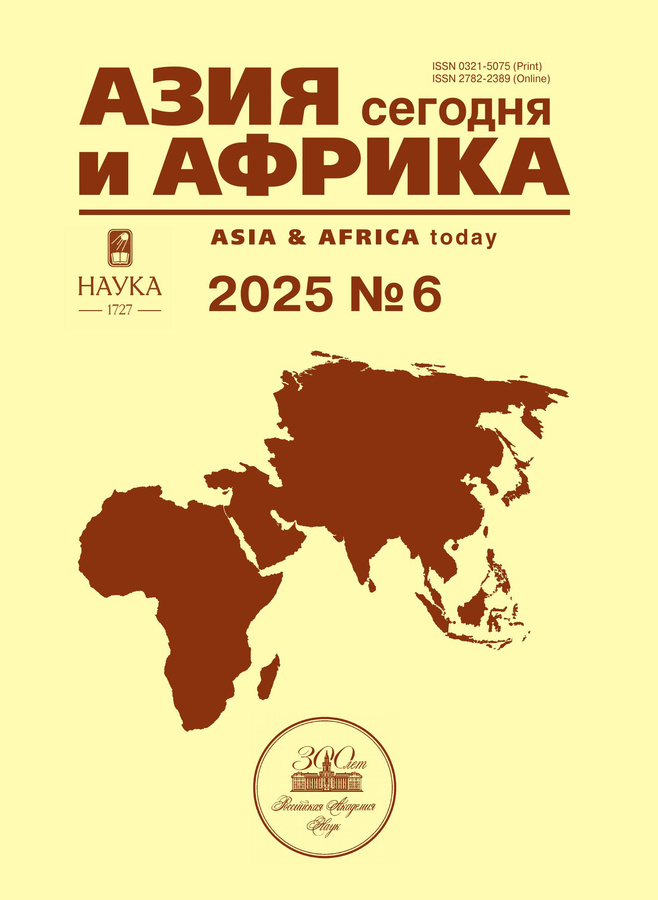Ethiopia: The Amhara Conflict, or the Fano Rebellion
- 作者: Denisova T.S1, Kostelyanets S.V1,2,3
-
隶属关系:
- Institute for African Studies, Russian Academy of Sciences
- HSE University
- Peoples’ Friendship University of Russia named after Patrice Lumumba
- 期: 编号 6 (2025)
- 页面: 35-44
- 栏目: Politics, economics
- URL: https://bulletin.ssaa.ru/0321-5075/article/view/685407
- DOI: https://doi.org/10.31857/S0321507525060045
- ID: 685407
如何引用文章
详细
Ethiopia is home to numerous ethnic groups, each with distinct languages, customs, and traditions. While this ethnic diversity has shaped the country’s rich cultural heritage, it has also fueled domestic political tensions under the legacy of “divide and rule” policies perpetuated by successive regimes, including post-imperial rulers (i.e., those after 1974). These tensions often escalate into conflicts, particularly when issues of political representation and resource distribution intersect with narratives of historical grievances. Despite recent rapid economic growth, which enabled Ethiopia to join BRICS in 2024, persistent challenges such as poverty, unemployment, and income inequality exacerbate interethnic divisions and contribute to instability. This is evidenced by successive conflicts in the Tigray, Oromia, and Amhara regions. While the Tigray conflict (2020–2022) between the Tigrayan people and the central government has been examined in several works by Russian Africanists, the subsequent unrest in Amhara State and the ongoing conflict between the federal government and the Amhara Fano militia have yet to receive sufficient scholarly attention in Russian academia. This article aims to address this gap.
作者简介
T. Denisova
Institute for African Studies, Russian Academy of Sciences
Email: tsden@hotmail.com
PhD (History), Leading Researcher, Head, Centre for the Study of Africa South of Sahara Moscow, Russia
S. Kostelyanets
Institute for African Studies, Russian Academy of Sciences; HSE University; Peoples’ Friendship University of Russia named after Patrice Lumumba
Email: sergey.kostelyanyets@gmail.com
PhD (Political Science), Leading Researcher, Head, Centre for Sociological and Political Sciences Studies; Senior Researcher; Associate Professor, Department of Oriental and African Studies Moscow, Russia; Moscow, Russia; Moscow, Russia
参考
- Мезенцев С.В., Копытцев И.С. Конфликт в Тиграе два года спустя: политические последствия для Эфиопии. Азия и Африка сегодня. 2025. № 5. С. 45–53. doi: 10.31857/S0321507525050055
- Mezentsev S.V., Kopyttsev I.S. 2025. Two Years after the Tigray Conflict: Political Consequences for Ethiopia. Asia and Africa today. № 5. Pp. 45–53. (In Russ.). doi: 10.31857/S0321507525050055
- Львова Э.С. Эта многоликая Эфиопия. Очерки по истории, культуре, этнографии. М.: Ключ-С, 2013.
- Lvova E.S. 2013. This Multifaceted Ethiopia. Essays on History, Culture, Ethnography. Moscow. (In Russ.)
- Балашова Г.А. Очерки культурной политики Эфиопии – взгляд сквозь эпохи. М.: Институт Африки РАН, 2018.
- Balashova G.A. 2018. Essays on the Cultural Policy of Ethiopia – a View Through the Ages. Moscow. (In Russ.)
- Исмагилова Р.Н. Эфиопия: особенности федерализма. М.: Институт Африки РАН, 2018.
- Ismagilova R.N. 2018. Ethiopia: Features of Federalism. Moscow. (In Russ.)
- Исмагилова Р.Н. Эфиопия: история и современность. М.: Институт Африки РАН, 2025.
- Ismagilova R.N. 2025. Ethiopia: History and Modernity. Moscow. (In Russ.)
- The Military Balance. L.: Routledge.
- Admassu M.D. 2019. Causes of Ethnic Conflict in Ethiopia and its Effect on Development: the Case of ‘Amhara’ and ‘Gumuz’ Communities. Journal of Sustainable Development in Africa. Vol. 21. № 3. Pp. 64–79.
- Teshome M.Z. 2021. Management of Ethnic Conflict in Ethiopia: The Case of Amhara and Oromo Ethnic Groups. Journal of Law and Conflict Resolution. Vol. 12. № 2. Pp. 25–33. doi: 10.5897/JLCR2021.0335
- Darch C. The Rise of the Amhara State. 1977. The African Review. Vol. 7. № 3/4. Pp. 106–109.
- Necho A., Debebe Y. 2024. Understanding the Fano Insurgency in Ethiopia’s Amhara Region. Rift Valley Institute. https://riftvalley.net/wp-content/uploads/2024/02/Understanding-the-Fano-Insurgency_final-1.pdf (accessed 15.02.2025)
- Исмагилова Р.Н. «Кеерроо» (молодежь оромо) – инициатор и активный участник протестных движений (Эфиопия). Ученые записки Института Африки РАН. 2019. № 3. С. 86–96. doi: 10.31132/2412-5717-2019-48-3-86-96
- Ismagilova R.N. 2019. “Qeerroo” (Oromo youth) – Initiator and Active Participant in the Protest Actions (Ethiopia). Journal of the Institute for African Studies. № 3. Pp. 86–96. (In Russ.)
补充文件









